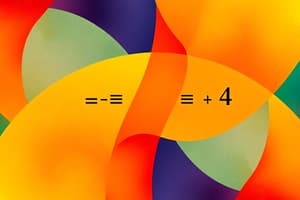Podcast
Questions and Answers
Which symbol represents the set union operation?
Which symbol represents the set union operation?
- \\(\\cup\\) (correct)
- \\(\\subseteq\\)
- \\(\\cap\\)
- \\(\\subset\\)
What is a set defined as in mathematics?
What is a set defined as in mathematics?
- A collection of repeating elements
- A collection of distinct elements enclosed within curly brackets (correct)
- A collection of negative elements
- A collection of random elements
What does the set intersection of two sets contain?
What does the set intersection of two sets contain?
- Elements that are different in both sets
- Elements unique to each set
- All elements from both sets
- Elements that are common to both sets (correct)
If set A = {2, 5, 8, 11} and set B = {3, 7, 10}, what is A - B?
If set A = {2, 5, 8, 11} and set B = {3, 7, 10}, what is A - B?
What does the empty set contain?
What does the empty set contain?
How are sets utilized in algebra?
How are sets utilized in algebra?
What role do sets play in probability and statistics?
What role do sets play in probability and statistics?
How does the 'No Search' feature in Microsoft Bing Chat leverage sets?
How does the 'No Search' feature in Microsoft Bing Chat leverage sets?
Why are sets considered the backbone of mathematics?
Why are sets considered the backbone of mathematics?
In what way do sets benefit students in understanding mathematical concepts?
In what way do sets benefit students in understanding mathematical concepts?
Flashcards are hidden until you start studying
Study Notes
Venturing into the World of Maths: Sets 101
Maths, a subject that challenges and intrigues us, is built upon the foundations of sets, a fundamental concept that unites and classifies elements in a structured, organized manner. As we delve into this topic, let's explore the world of sets with a practical approach that celebrates the beauty of maths.
What Exactly is a Set?
A set is a collection of distinct elements, or members, enclosed within curly brackets. Each element is identified uniquely, and the same element can only appear once in a set. For example, the set (A = {2, 5, 8, 11}) contains four distinct, positive integers.
Operations on Sets
Sets are not static, as they can be combined and compared using various operations. These operations include:
-
Set Union: The set union of two sets contains all elements from both sets. The symbol for set union is (\cup). For example, (B = {3, 7, 10}), and (C = {2, 5, 8, 11, 3}). Then, (B \cup C = {2, 3, 5, 7, 8, 10, 11}).
-
Set Intersection: The set intersection of two sets contains elements that are common to both sets. The symbol for set intersection is (\cap). Using the same example, (B \cap C = {3}).
-
Set Difference: The set difference of set (A) with respect to set (B), denoted as (A - B), contains the elements of set (A) that are not present in set (B). For example, (A - C = {2, 8, 11}).
-
Empty Set: The empty set, denoted as (\emptyset) or ({}), contains no elements.
Applications of Sets in Maths
Sets are an essential tool in various mathematical fields, such as:
- Algebra: Sets are used to describe the domain and range of functions, as well as to define classes of functions.
- Geometry: Sets are used to describe points, lines, and shapes.
- Probability and Statistics: Sets are used to describe events, populations, and sampling methods.
Sets in Context
The upcoming Microsoft Bing Chat "No Search" feature, a plugin that allows users to solve complex math problems without connecting to the web, highlights the power of sets. By utilizing sets, Bing Chat can solve problems without relying on web search results, providing a tool that's faster and more efficient than traditional search engines.
In summary, sets are the backbone of maths, providing a structured framework for organizing and understanding a wide variety of mathematical concepts. As you continue your maths journey, sets will serve as a powerful tool for unlocking the mysteries of our universe.
Studying That Suits You
Use AI to generate personalized quizzes and flashcards to suit your learning preferences.




